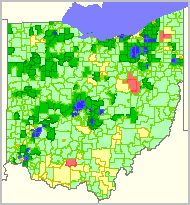Ohio’s Plunderbund Examines Correlation of School District Ratings with Family Income
For many years Ohio has used a Performance Index to judge its school districts. The Performance Index is a formula based primarily on standardized test scores. Not too long ago at a meeting, when someone pointed out that the Performance Index seems to reflect family wealth and may not, in fact, represent school quality, an expert responded that we pretty much have to use the Performance Index as an indicator of school quality in Ohio because it is really the only long standing, reliable indicator we have. I wondered about this at the time. A rating system that is wrong and that unfairly assigns blame, however handy, doesn’t seem to me to be a good tool to use.
(Of course there is also the question about why we are creating a competition in the first place—ranking and rating school districts when they serve different children and they are located in different kinds of communities.)
Finally this year people are paying more attention to how Ohio’s school district performance ratings are calculated, because Ohio is in the process of moving from a ranking of “Excellent, Effective, Continuous Improvement, Academic Watch and Academic Emergency” to a more damning system for many school districts—A, B, C, D, and F. Many of the school districts caught in the “Continuous Improvement” range have been able to benefit from the quaisi-positive frame of that term. Now some of those supposedly “C” school districts will fall to the D or F category. And the stakes are high. Last week this blog (here) quoted a statement from a 2005 National Council of Churches document that clarifies one of the serious consequences in actual practice of evaluating schools and school districts by students’ test scores, a practice codified in 2002 in the federal testing law No Child Left Behind: “The No Child Left Behind Act exacerbates racial and economic segregation in metropolitan areas by rating homogeneous, wealthier school districts as excellent, while labeling urban districts with far more subgroups and more complex demands made by the law as ‘in need of improvement.’ Such labeling of schools and districts encourages families with means to move to wealthy, homogeneous school districts.”
Over the weekend the Columbus, Ohio blog Plunderbund published an investigation of the meaning and impact of Ohio’s Performance Index. Plunderbund concludes: “If you live in the vast majority of Ohio’s communities (92.7%) where the median income is less than $45,000, your school district has less than 1% of a chance at receiving an A on John Kasich’s report card… Nine years’ worth of data appear to reveal that the best way to improve student test scores is to increase the community’s income. So we must ask ourselves—What are Ohio’s Ohio’s Plunderbund Examines Correlation of School District Ratings with Family Income | janresseger:

